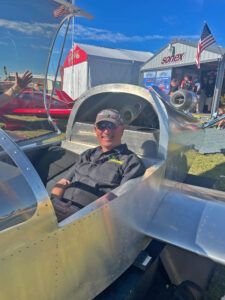 I am probably one of the higher-time SubSonex JSX-2 pilots around, so it was with great interest that I dropped in at the Sonex booth as soon as they “rolled out” their two-seat prototype for a fit check in the cockpit. The airplane is noticeably larger than its single-seat counterpart, and the roominess is most apparent in the cockpit height. Whereas my flight helmet just barely clears the single-seat canopy, I probably had close to a foot of clearance with the JSX-2T version. John Monnett, former owner but still a consultant to Sonex, told me that he is planning on re-contouring the canopy to make ti more compact and decrease frontal area.
I am probably one of the higher-time SubSonex JSX-2 pilots around, so it was with great interest that I dropped in at the Sonex booth as soon as they “rolled out” their two-seat prototype for a fit check in the cockpit. The airplane is noticeably larger than its single-seat counterpart, and the roominess is most apparent in the cockpit height. Whereas my flight helmet just barely clears the single-seat canopy, I probably had close to a foot of clearance with the JSX-2T version. John Monnett, former owner but still a consultant to Sonex, told me that he is planning on re-contouring the canopy to make ti more compact and decrease frontal area.
The JSX-2T is being displayed with the same PBS TJ-100 engine as the single-senate aircraft. It produces 257 lb of static thrust, with an average fuel burn of about 20 gallons per hour over a typical flight profile. The Single seater carries 40 gallons, whereas the two-seat version sports 50. The single seater weighs in at 1000 lb Gross, and the two-seat is targeted for 1500.
The factory scrambled to get the two-seat fuselage, wings, and tail ready for display at this year’s AirVenture so that the anxiously-awaited design could be revealed for feedback from potential customers.


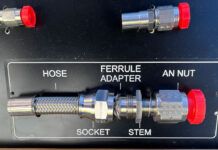

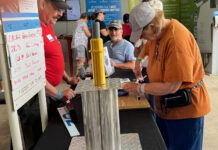

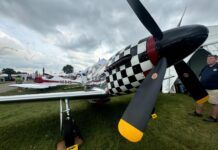




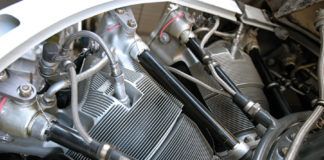
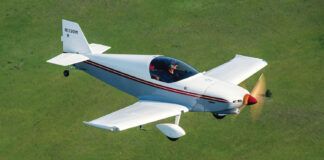
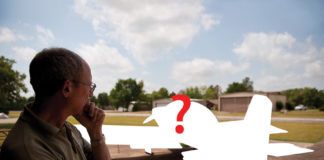
Maybe it could use two TJ-100s mounted on the wings, like the HondaJet.?
But fuel burn would be an issue… !
I like the idea of having two turbojet engines, or better yet, future small turbofan powerplants in a personal two seat aircraft, with more space for luggage and perhaps some additional flight endurance time. Something that approaches 41/2 plus hours with a gross weight of about 2650 pounds. So two 180 pound adults, 180 pounds of luggage and 700 pounds of JetA, which adds up to a useful load of 1240 pounds and an empty weight of about let us say 1400 pounds . That is close to the weight of many four place Cessna 172 or smaller Piper Cherokees and other 2-4 seat aircraft. While these would be experimental aircraft and have about a 160-180 knot cruise with a 18,000 foot or higher ceiling, they would be similar to many aircraft used in GA today, with the lighter weight turbine powerplants. Now, we approaching a practical aircraft. Now, another concept, a JetA diesel powered piston engine in front and a turbojet powerplant in back. So, both engines for take off, and once in flight the turbine could be shut down for longer cruise and economy, at let us say 140-150 knots. This concept was used in WWII by Ryan Aircraft in the Firebee, a test aircraft. Then another crazy idea for existing piston powered aircraft. Mount a turbojet or two under the wings or under the belly like was done to many military aircraft for that extra boost. That is why I love the progress that EAA members are making in and for General Aviation. Keep Dreaming, Be safe!
Put two TJ-100s mounted under the wings and a cuneiform tail. Voila, a mini ME-262….
Who cares about fuel burn, where would you put the machine guns?
Those little turbofans are so light, it would be cool if they could mount two — one on each side of the fuselage, like a Learjet. Would need a bigger fuel tank though. I wonder what the cruise speed would be?
I’m waiting for the tri-jet.